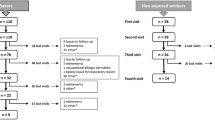Abstract
Background: The prevalence of diagnosed asthma and wheezing in young subjects is increasing; among environmental risk factors, occupational exposure can play a relevant role. Study objectives: The purpose of the study was to evaluate the effects of occupational exposure to a large variety of irritants and/or sensitizers on the incidence of respiratory symptoms and pulmonary function impairment in a group of young apprentices during the first year of work exposure, and to determine the prevalence of asthma-like symptoms and the role of different risk factors (gender, smoking habit, atopy and occupational exposure) in this young population. Design and methods: We studied 448 young apprentices at the first pre-employment evaluation with a standardized questionnaire, spirometry and skin prick tests; in 244 of them clinical and functional evaluation was repeated after 1 year exposure to respiratory irritants or sensitizers. Results: At the first examination, males had higher prevalence of attacks of shortness of breath with wheeze, diagnosis of asthma, smoking habit and atopy than females. At the second examination there was no significant increase in the prevalence of respiratory symptoms. However, incident cases for cough, phlegm, wheezing, shortness of breath with wheeze (SOBWHZ) and asthma were all higher than remittent cases. Incidence of respiratory symptoms was associated with atopy and smoking habit. Conclusions: Respiratory symptoms slightly increase over 1 year occupational exposure to sensitizers or irritants. The loss at the follow-up of subjects with higher smoking habit suggests a small “health worker effect” and could underestimate the effect of occupational exposure in apprentices.
Similar content being viewed by others
References
American Thoracic Society (1987) Standardization of spirometry. Am Rev Respir Dis 136:1285–1298
Anderson HR et al (1992) Asthma from birth to age 23: incidence and relation to prior and concurrent atopic disease. Thorax 47:537–542
Archambault S et al (2001) Incidence of sensitization, symptoms, and probable occupational rhinoconjunctivitis and asthma in apprentices starting exposure to latex. J Allergy Clin Immunol 107:921–923
Burrows B, Martinez FD (1989) Bronchial responsiveness, atopy, smoking and chronic obstructive pulmonary disease. Am Rev Respir Dis 140:1515–1517
De Zotti R, Bovenzi M (2000) Prospective study of work related respiratory symptoms in trainee bakers. Occup Environ Med 57:58–61
Dodge RR, Burrows B (1980) The prevalence and incidence of asthma and asthma-like symptoms in a general population sample. Am Rev Respir Dis 122:567–575
Dosman JA et al (1991) Atopic status as a factor in job decision making in grain workers. J Occup Med 33:1007–1010
European Community Respiratory Health Survey (1996) Variations in the prevalence of respiratory symptoms, self-reported asthma attacks, and use of asthma medication in the European Community Respiratory Health Survey (ERCHS). Eur Respir J 9:687–695
Gautrin D et al (2002) Host determinants for the development of allergy in apprentices exposed to laboratory animals. Eur Respir J 19:96–103
Katz I et al (1999) The occurrence, recrudescence, and worsening of asthma in a population of young adults Impact of varying types of occupation. Chest 116:614–618
Kennedy SM et al (1999) Change in airway responsiveness among apprentices exposed to metalworking fluids. Am Respir Crit Care Med 159:87–93
Kogevinas M et al (1996) The risk of asthma attributable to occupational exposure:a population based study in Spain. Am J Respir Crit Care Med 154:137–143
Laor A et al (1993) Effects of time, sex, ethnic origin, and area of residence on prevalence of asthma in Israeli adolescents. B M J 307:841–844
Malo JL et al (1992) Natural history of occupational asthma: relevance of type of agent and other factors in the rate of development of symptoms in affected subjects. J Allergy Clin Immunol 90:937–944
Milton DK et al (1998) Risk and incidence of asthma attributable to occupational exposure among HMO members. Am J Ind Med 33:1–10
Monso’ E et al (2000) Individual characteristics and quitting in apprentices exposed to high-molecular-weight agents. Am J Respir Crit Care Med 161:1508–1512
Nish WA, Schwietz LA (1992) Underdiagnosis of asthma in young adults presenting for USAF basic training. Ann Allergy 69:239–242
Niven RM, Pickering CA (1999) Is atopy and smoking important in the workplace? Occup Med 49:197–200
Paoletti P et al (1986) Reference values for vital capacity and flow-volume curves from a general population study. Bull Eur Physiopathol Respir 22:451–459
Peat JK (1994a) The rising trend in allergic illness: which environmental factors are important. Clin Exp Allergy 24:797–800
Peat JK et al (1994b) Differences in airway responsiveness between children and adults living in the same environment: an epidemiological study in two regions of New South Wales. Eur Respir J 7:1805–1813
Renstrom A et al (1995) Allergic sensitization is associated with increased bronchial responsiveness: a prospective study of allergy to laboratory animals. Eur Respir J 8:1514–1519
Smith TA, Patton J (1999) Health surveillance in milling, baking and other food manufacturing operations-five year’s experience. Occup Med 49:147–153
Tarlo SM (2000) Workplace respiratory irritants and asthma in Occupational Medicine. State of the art rewiews: occupational asthma. Hanby and Belfus Inc, Philadelphia, vol 15, issue 2, pp 471
Viegi G et al (1988) Prevalence of respiratory symptoms in an unpolluted area of northern Italy. Eur Respir J 136:1285–1298
Viegi G et al (1991) Prevalence rates of respiratory symptoms in Italian general general population samples, exposed to different levels of air pollution. Environ Health Perspect 94:95–99
Viegi G et al (1999) Prevalence rates of respiratory symptoms and diseases in general population samples of North and Central Italy. Int J Tuberc Lung Dis 3:1034–1042
Von Mutius E (2000) The environmental predictors of allergic disease. J Allergy Clin Immunol 105:9–19
Zhong Y et al (2002) Lung function and symptoms among cotton workers and dropouts three years after the start of work. Int J Occup Environ Health 8:297–300
Author information
Authors and Affiliations
Corresponding author
Rights and permissions
About this article
Cite this article
Talini, D., Monteverdi, A., Lastrucci, L. et al. One-year longitudinal study of young apprentices exposed to airway occupational sensitizers. Int Arch Occup Environ Health 79, 237–243 (2006). https://doi.org/10.1007/s00420-005-0040-0
Received:
Accepted:
Published:
Issue Date:
DOI: https://doi.org/10.1007/s00420-005-0040-0




